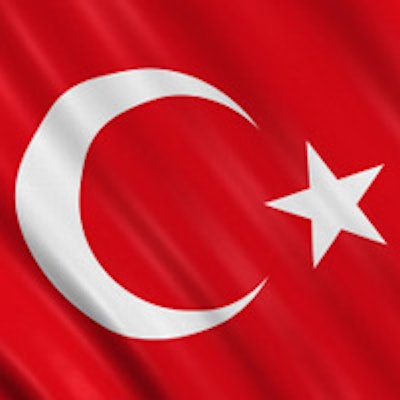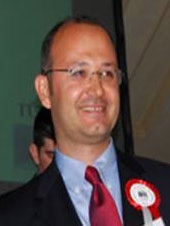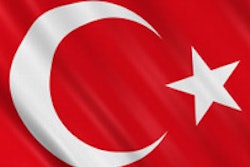
The European Society of Radiology has invited researchers in Turkey to outline the latest advances in national imaging at ECR 2015, and clearly they're relishing the prospect. The subjects chosen -- functional brain MRI, percutaneous treatment of liver hydatid cysts, and advanced hepatopancreaticobiliary imaging -- highlight the emergence of high-end imaging in the country.
_170.png?auto=format%2Ccompress&fit=max&q=70&w=400) Turkey is one of the best countries in Europe for radiology practice and research, according to Dr. Şukru Mehmet Ertürk.
Turkey is one of the best countries in Europe for radiology practice and research, according to Dr. Şukru Mehmet Ertürk.
"Turkey, in my opinion, is among the top countries for radiology practice and research in Europe. The number of Turkish radiologists passing the European Board of Radiology exam is an important indicator," said Dr. Şukru Mehmet Ertürk, attending radiologist and administrative chief in the department of radiology at Şişli Etfal Training and Research Hospital in Istanbul, and executive board member of the Turkish Society of Radiology (TSR).
He points to ongoing collaboration with other European and international societies; for instance, the latest joint meeting between the German, Austrian, and Turkish societies, held in Istanbul earlier in May, resulted in the decision to hold the meeting annually and implement academic exchange programs for residents. Ertürk thinks percutaneous treatment of live hydatid cysts is interesting because hydatid cyst disease is endemic in Turkey and successful outcomes may be achieved using interventional radiology.
Other radiologists echo his view, stating that Turkish radiology sits somewhere between U.S. and European practice, and even though the salaries are not yet on a par with either region, the service provided by Turkish radiologists is.
Healthcare reforms
Turkish healthcare has undergone major reforms since 2003, and now is more affordable and accessible for citizens. The country's social security system covers approximately 99% of the total population, around 75.2 million people, which is an increase of 29% from 2002. In the last few years, even stateless persons and refugees have been included under the country's universal health insurance policy. Radiology departments have also expanded their capacity with state-of-the-art machines to cope with an increasing patient throughput.
However, along with the benefits to patients, the reforms have brought with them other challenges, and not least to imaging departments, according to Turkish radiologists, who cite disadvantages such as an increasing workload, reduced reimbursement, and fewer residency places. This means that optimizing efficiency and performance has never been more important. The TSR and the country's other subspecialty societies continue to push for ongoing improvements in practice. Interventional radiology (IR) is a current focus.
"IR has not yet become a governmentally recognized subspecialty of radiology in Turkey, as pediatric radiology did two years ago," said Dr. Ismail Oran, professor and head of the interventional radiology section in the department of radiology at Ege University Hospital in Izmir, and past president of the Turkish Society of Interventional Radiology (TGRD). "However, Turkey's Higher Education Council recognized three subspecialties 15 years ago; IR, neuroradiology, and pediatric radiology."
For interventional radiology, the routine residency program has a three- to six-month rotation, and after completion most radiologists are capable of performing basic nonvascular interventions such as biopsies of the lung, thyroid, liver, kidney, and abdominal masses, drainage of empyema, ascites, abscesses, and cysts. They will also be able to perform basic diagnostic angiographies, including carotid, renal, mesenteric, and aortofemoral.
"Radiologists wishing to be an IR in an academic setting have to complete an IR rotation in any high-volume center in the country, which lasts a minimum of six months. There is currently no common certification program -- individual centers give their own certification. However, the Turkish Society of IR has recently launched a common program," Oran said.
The program has three components; basic IR, basic peripheral vascular IR, and advanced peripheral vascular IR. The future plan is to organize, together with the Turkish Society of Neuroradiology, a fourth course: neurovascular IR.
The first course of basic IR took place in February of this year with 75 participants. In addition, the TGRD organizes a national IR meeting every March. The ninth meeting in 2014 involved more than 450 delegates and 20 companies.
Workload changes
Dr. Muşturay Karçaaltıncaba, abdominal and cardiovascular radiologist in the department of radiology at Hacettepe University School of Medicine in Ankara, describes a situation in which imaging workload is increasing, and proportionally pay derived from points, a system which complements state radiologists' basic salary, has been reduced.
 Coping with an increasing workload for less pay is one of the challenges of current daily practice for radiologists, Dr. Muşturay Karçaaltıncaba said.
Coping with an increasing workload for less pay is one of the challenges of current daily practice for radiologists, Dr. Muşturay Karçaaltıncaba said.
Although the cost of CT and MRI scans has been steady for the past five years, reimbursement for state and university radiologists is decreasing as they are obliged to read more exams than they used to in order to earn the same amount of points as before.
Furthermore, an increasing general case workload means that there is less time to dedicate to complex patients.
"The current government gained at least 10% of the vote due to improvements made in the medical system for normal patients, which has involved short or no waiting times for imaging -- a situation that doesn't exist even in a country like Sweden. Unfortunately, allocating more resources for 'simple' patients means fewer resources for complex patients."
The government's focus on eliminating waiting times is pressuring the system, and there is still a backlog of patients in university hospitals, according to Karçaaltıncaba, who cites cancer patients as forming 70% to 80% of the patient population at Hacettepe.
"Radiologists in Turkey do three to four times more reading than a U.K. radiologist and for far less pay," Karçaaltıncabasaid. "Also, time allocated for academic studies is decreasing, which might jeopardize academic productivity."
Brain drain?
The number of MRI and CT devices in Turkey per 1 million people is 12.2 and 15.1, respectively. With growth in population, healthcare spending, and considering the government's continuous efforts to modernize healthcare infrastructure and advances in service quality, the number of MRI and CT units is expected to increase between 2013 and 2018.
Planned expansion in healthcare infrastructure will also necessitate greater numbers of radiologists. Part of the government's reform program aims to encourage doctors to return to Turkey from overseas, and help keep qualified specialists in the country to practice, rather than opting to work abroad.
Karcaaltınçaba does not think there is a danger of Turkey losing its radiologists. He himself came back from a one-year fellowship in the U.S. in 2002, and points to a 20-fold increase in the past 10 years in the government's budget for research in medicine and engineering.
Dr. Orhan Ozkan, interventional radiology program director at the University of Wisconsin School of Medicine and Public Health and a former fellow in a Texas hospital in the U.S., reports that he has trained many Turkish residents in his department.
"As far as I know, some of the trainees come to the U.S. as clinical fellows -- as I did years ago -- and they are paid by the U.S. hospitals. Some come here as observers and they finance themselves or have found scholarships in Turkey for their training here," Ozkan said. "Some return to Turkey, but others stay."
Meanwhile, residencies in Turkey are hard-earned. Twice a year, 3,000 doctors undertake the central residency exam after medical school in order to find a program. Top slots depend on the doctor's score.
 Residencies have been cut by more than 60% since 2011, Dr. Nevzat Karabulut noted.
Residencies have been cut by more than 60% since 2011, Dr. Nevzat Karabulut noted.
"In Hacettepe, out of 3,000 doctors we take on three residents from the top 10 scores," Karcaaltınçaba said. "This competitive edge has led to improvement in scientific quality. On the negative side, because of increased workloads, university doctors have less time for research and writing academic articles."
Compounding workloads is the squeeze on residencies across all disciplines. The government's stance seems to rest on a decision to cut residencies in favor of increasing the number of teaching hospitals, and a shift toward encouraging doctors to become general practitioners rather than specialists.
"This is poor planning, in my opinion," Ertürk said.
Five years ago, Hacettepe took on 40 residents, and this number has been annually reduced to reach 25 in 2014, according to Karçaaltıncaba. Other radiologists report a similar proportional reduction.
"The cut rate is about 60% to 75%. It started in 2011," said Dr. Nevzat Karabulut, chairman and section chief of body imaging at the Pamukkale University School of Medicine in Denizli, and the editor in chief of Diagnostic and Interventional Radiology, the official journal of the TSR. "My institution was acquiring two to three residents a year. In 2011 and 2012, we got only one in the two-year period. In 2013, we acquired one in a year. All specialty societies suffering from this cut are still negotiating with the authorities and we hope to straighten it out soon."
Facts and figures
In 2012, there were 18,666 medical imaging devices in healthcare facilities in Turkey. Due to the increasing population, healthcare spending, continuous efforts to modernize healthcare infrastructure, and advances in service quality, growth is expected to accelerate between 2013-2018, according to the Investment Support and Promotion Agency of Turkey (ISPAT).
| Number of medical imaging devices in healthcare facilities, 2012 | ||||
| Ministry of Health | University | Private | Total | |
| MRI | 310 | 89 | 522 | 921 |
| CT | 448 | 122 | 572 | 1,142 |
| Ultrasound | 2,348 | 384 | 1,508 | 4,240 |
| Doppler ultrasound | 1,218 | 302 | 943 | 2,463 |
| Echo | 587 | 188 | 592 | 1,367 |
| Mammography | 353 | 77 | 506 | 936 |
| X-ray | 3,554 | 2,165 | 1,878 | 7,597 |
Turkey's median age will reach 34 in 2023, 42.9 in 2050, and 47.4 in 2075. The percentage of the population older than age 65 also is rising and will reach 10% of the total population in 2023 and 28% in 2075.
The Turkish economy rapidly expanded in the last decade with per capita gross domestic product (GDP) expanding at a compound annual growth rate (CAGR) of 25.1% between 2002 and 2012 from 2,523 euros in 2002 to 7,742 euros in 2012. Healthcare spending per capita grew at a CAGR of 30.6% during 2002-2012 from 136 euros to 519 euros. Healthcare spending per capita has been targeted to almost triple by 2023, reaching 1,467 euros.
Healthcare spending is expected to surpass the forecasted world average rate, and surge to a CAGR of 5.6% between 2013 and 2017, while developed countries will be experiencing relatively lower growth rates. Health and social work activities increased at a CAGR of 39% between 2008 and 2012, amounting to $400 million euros.
Turkey's medical device market is ranked as the largest in the region of the Middle East and Africa, and reached more than 1.6 billion euros in 2012. Moreover, it is forecasted to grow at a CAGR of 8.5% through to 2018.
The Turkish Society of Radiology has more than 3,000 members and organizes the Turkish Congress of Radiology, which is held every year in the second week of October. Each year, more than 1,500 radiologists attend this meeting. The society also publishes Diagnostic and Interventional Radiology, a bimonthly journal published entirely in English and available free to all readers.



















